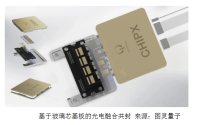this seems like a huge breakthrough..
on November 15 that the team led by Zhan Mingsheng and Xu Peng from the Institute of Precision Measurement, Chinese Academy of Sciences, has made significant progress in the field of neutral atom quantum computing.
The team innovatively proposed and experimentally demonstrated a new architecture for neutral atom quantum computing based on fiber arrays, which solves the problem that atomic quantum computing is difficult to achieve simultaneously with high parallelism, high speed and high stability addressing and manipulation.

Neutral atom quantum computing has become one of the leading approaches in quantum computing hardware due to its excellent scalability, high-fidelity gate manipulation, long coherence time, and reconfigurable connections. Similar to classical computing, addressing capability determines programmability. Therefore, high-quality addressing manipulation is not only a key technology for running various quantum algorithms and driving quantum computing applications, but also the cornerstone for realizing universal, fault-tolerant quantum computing. In neutral atom quantum computing, existing addressing schemes cannot simultaneously achieve high parallelism, high speed, and high stability in addressing manipulation.
the research team took a unique approach, designing a novel fiber array architecture. The core of this architecture lies in configuring a completely independent control channel for each qubit. The trapping and addressing light for each atomic qubit is transmitted through the same single-mode fiber and focused in a vacuum via a shared optical path to form optical tweezers. This shared-path design allows the control beam to be naturally aligned spatially with the atomic traps, fundamentally eliminating optical path misalignment caused by mechanical vibration or thermal drift, and providing a physical guarantee for achieving stable and independent quantum control.
Chinese scientists have achieved a new architecture for neutral atom quantum computing based on fiber optic arrays, achieving a single-atom addressing fidelity of 99.66%.
on November 15 that the team led by Zhan Mingsheng and Xu Peng from the Institute of Precision Measurement, Chinese Academy of Sciences, has made significant progress in the field of neutral atom quantum computing.
The team innovatively proposed and experimentally demonstrated a new architecture for neutral atom quantum computing based on fiber arrays, which solves the problem that atomic quantum computing is difficult to achieve simultaneously with high parallelism, high speed and high stability addressing and manipulation.

Neutral atom quantum computing has become one of the leading approaches in quantum computing hardware due to its excellent scalability, high-fidelity gate manipulation, long coherence time, and reconfigurable connections. Similar to classical computing, addressing capability determines programmability. Therefore, high-quality addressing manipulation is not only a key technology for running various quantum algorithms and driving quantum computing applications, but also the cornerstone for realizing universal, fault-tolerant quantum computing. In neutral atom quantum computing, existing addressing schemes cannot simultaneously achieve high parallelism, high speed, and high stability in addressing manipulation.
the research team took a unique approach, designing a novel fiber array architecture. The core of this architecture lies in configuring a completely independent control channel for each qubit. The trapping and addressing light for each atomic qubit is transmitted through the same single-mode fiber and focused in a vacuum via a shared optical path to form optical tweezers. This shared-path design allows the control beam to be naturally aligned spatially with the atomic traps, fundamentally eliminating optical path misalignment caused by mechanical vibration or thermal drift, and providing a physical guarantee for achieving stable and independent quantum control.


